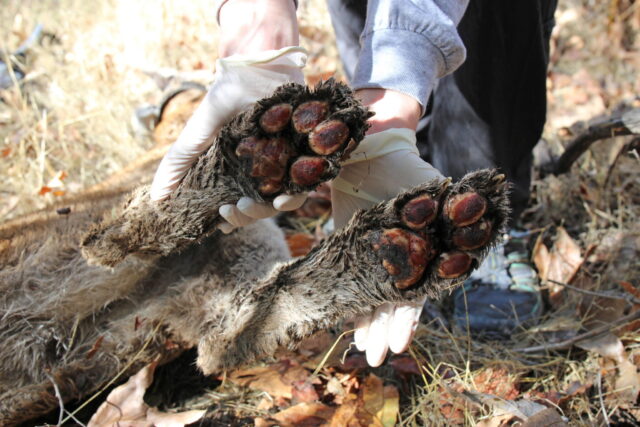P-64, an adult male mountain lion, travels through a tunnel under Highway 101, heading south toward the Santa Monica Mountains in 2018.
Credit:
National Parks Service
The cat traversed a long, dark tunnel under Highway 101, used by more than 350,000 cars a day, to reach a small patch of habitat north of the Santa Monica Mountains. Then he used another tunnel, made for hikers and equestrians, to reach a much larger open space to the north. But when the fire broke out, he didn’t have time to reach these escape routes.
Sikich could see from P-64’s GPS collar that he was in the Simi Hills when the fire started. He began heading south, but ran smack into a developed area, which adult males do their best to avoid, even without the chaos of evacuations and fire engines.
“So he had two options,” Sikich said. “He could have entered the urban area or turned around and go back onto the burnt landscape, which he did.”
A few weeks later, Sikich got a mortality signal from P-64’s radio collar. “We didn’t know at the time, of course, but when we found him, he had burnt paws,” he said. “So he died from the effects of the fire.”
The cat was emaciated, with smoke-damaged lungs. His burnt paws hindered his ability to hunt. He likely starved to death.
When the team compared collared cats 15 months before and after the fire, they saw that the surviving cats avoided the burned areas. Lions need cover to hunt but the area was “just a moonscape,” Sikich said. The loss of that habitat forced the cats to take greater risks, likely to find food.
Mountain lions tend to be more active around dawn and dusk, but after the fire, collared cats were more active during the day. That meant they were more likely to run into people and cross roads and even busy freeways, Sikich and his team reported in a 2022 study.
On Dec. 3, 2018, National Park Service researchers discovered the remains of P-64, who survived the flames of the Woolsey Fire but died a few weeks later. The lion was emaciated and likely starved to death, unable to hunt with burnt paws.
Credit:
National Park Service
“We expect animals, in the long run, to adapt to the environments in which they live,” said Blumstein, who contributed to the study. In California, they adapted to coastal chaparral fires but not to fires in a fragmented habitat dominated by development. And when animals adapt to something, there can be mismatches between what they see as attractive and what’s good for them, he explained.



